Coconut Chutney is a delightful South Indian condiment that pairs beautifully with breakfast and snack dishes like Idli, Dosa, Uttapam and Medu Vada. Here I share two simple recipes – a classic coconut chutney recipe with spice tempering, as well as a quick, hotel-style recipe that skips tempering. Learn how to make this essential Indian side dish with my easy-to-follow step-by-step photos and a video!
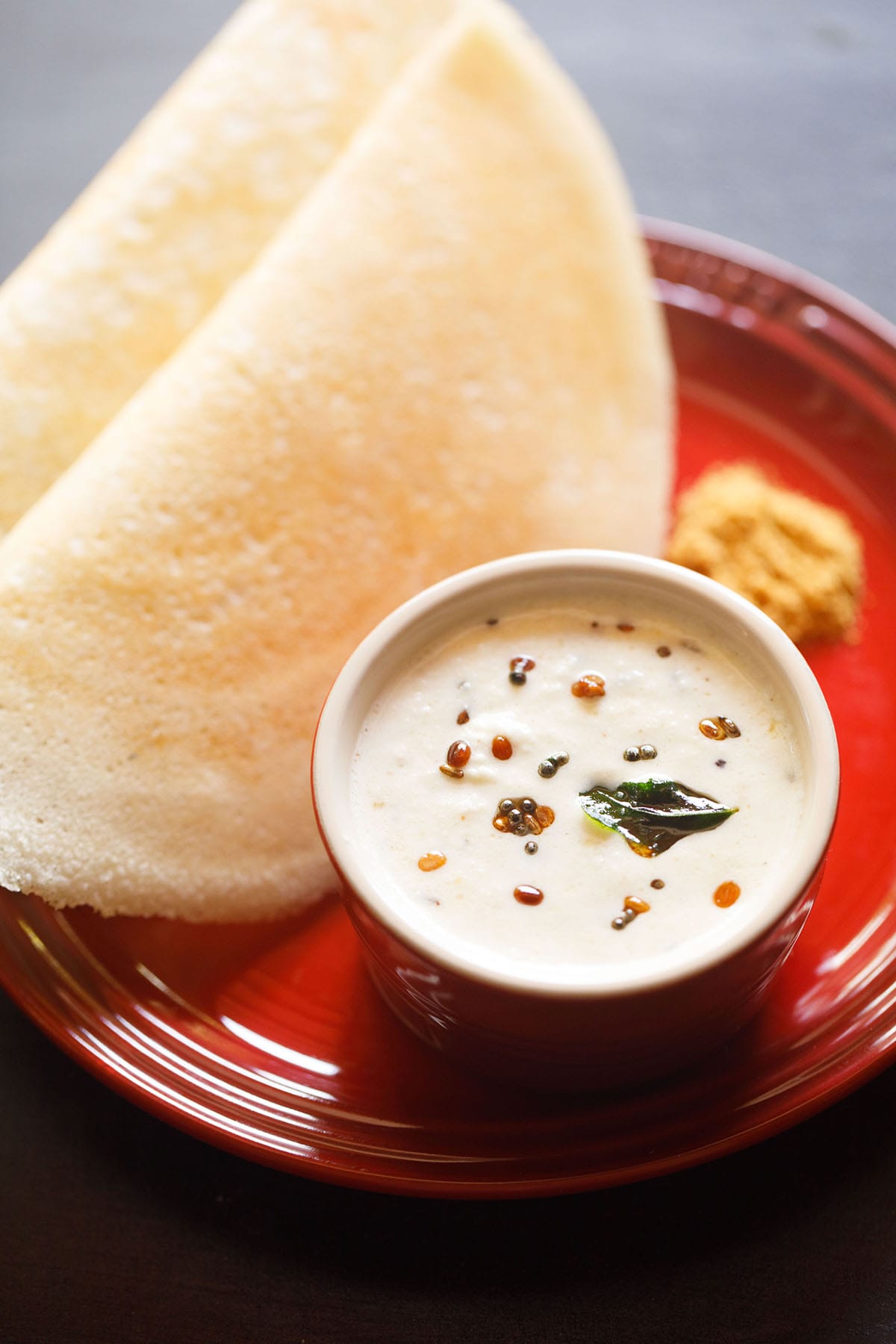
About Coconut Chutney
Chutneys are a class of condiments that originated in India and can be made from a multitude of different ingredients.
Just on this site, I have recipes for tomato, coriander, peanut, tamarind and onion chutneys, and that isn’t even my full list! All of these delicious savory sauces and relishes are used to enhance the flavors of various meals.
Coconut chutney originated from the South Indian cuisine. It is most often served with breakfast or snack dishes.
Table of Contents
In its simplest form, it is made by finely grinding fresh white coconut meat with either green chilies or dry red chilies and salt added to it.
Chilies lend a bit of heat and spice in the chutney. Garlic or ginger can be added for more savory depth.
A tempering of oil with crackled mustard seeds, fried urad dal (black gram), crisp curry leaves and asafoetida (hing) brings more flavor to otherwise plain coconut chutney.
Why This Recipe Works
I have been making this easy-peasy basic coconut chutney recipe for decades now, and it is still a favorite in our house. As someone who cooks very often, the fact that this coconut chutney makes regular appearances on our table should indicate just how delicious it is!
Made in the Tamil Nadu style, this particular recipe calls for roasted chana dal to be added. Also known as chana daria, these husked and split black chickpeas have a lovely rich and nutty taste.
While roasted chana dal are readily available for purchase in India, I know that they are not available everywhere. You can either opt to fry these lentils on your own at home, or simply skip it. Don’t worry, the coconut chutney will still be delicious without it.
If fresh coconut is not available to you, simply swap in frozen coconut or unsweetened dessicated coconut flakes instead. This easy recipe will work with whatever you have on hand.
You can also adjust the basic recipe by adding different ingredients. For example, if you add some roasted sesame seeds, dry red chilles and a touch of tamarind, it makes a lovely sauce for serving with steamed rice!
One of my favorite things about coconut chutney is how versatile it is! Apart from serving with breakfast foods like idli, dosa and vada, you can also serve it with tons of South Indian snacks.
We like to put it on Upma, Mysore Bonda, Onion Pakoda, Semiya Upma, Pongal and so many other dishes. I have a feeling that once you try it, coconut chutney will become one of your favorite condiments, too. When paired with Idli Sambar, it is even more enticing.
My mom-in-law who is Punjabi absolutely LOVES South Indian food, and this coconut chutney is one of her favorites. If you, like her, love anything with coconut, then you’re sure to love this traditional coconut sauce.
How to make Coconut Chutney
Grinding Ingredients
1. Add ½ cup tightly packed freshly grated coconut in a chutney grinder jar or a small grinder jar.
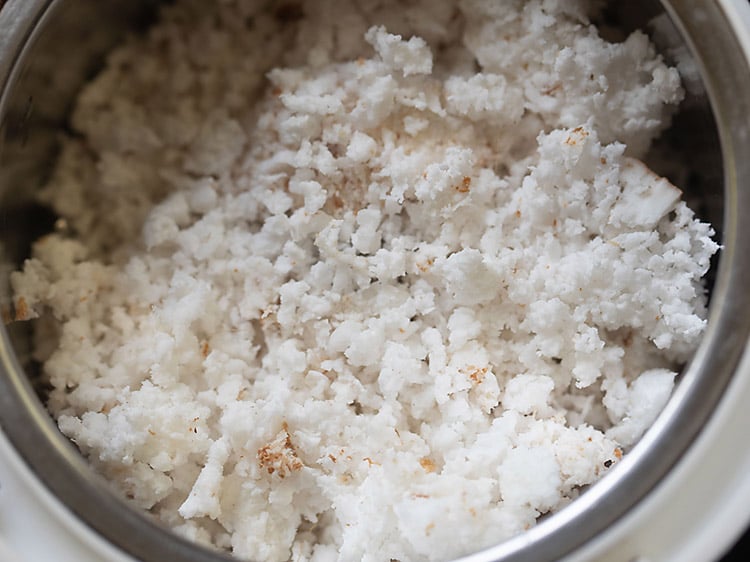
2. Add 1 to 2 chopped green chillies (depending on your heat preference), ½ inch chopped ginger (optional, can substitute with 2 small cloves of garlic) and 2 tablespoons roasted chana dal.
Note: 1 green chili will yield about ½ to 1 teaspoon of chopped chillies. I have used about ½ teaspoon of chopped green chillies. For a spicy coconut chutney, depending on the pungency of the chilies, consider to add 2 to 3 green chilies.
Tip: You can swap the Indian variety of green chillies with ½ teaspoon of Serrano or Anaheim peppers. If using Thai green chillies, add about ¼ teaspoon chopped as they are very spicy.
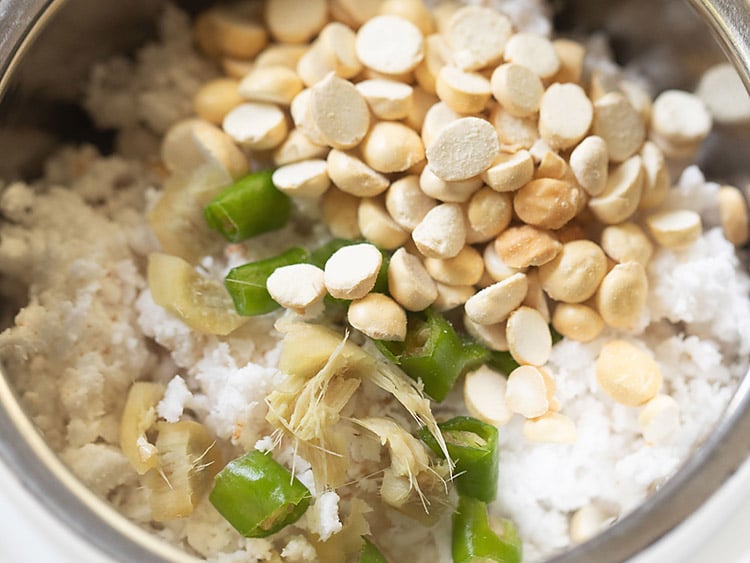
3. Add salt to taste. I suggest starting with less salt at first. Then, after grinding, check the taste and add some more salt if required. Remember, you can always add MORE salt, but you can’t take it away once it has been added.
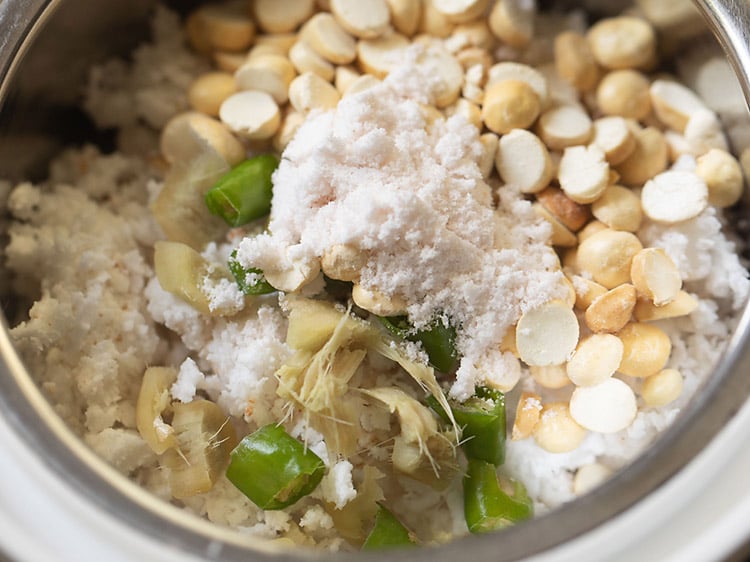
4. Add 3 to 4 tablespoons water. You can make this coconut chutney thicker by adding less water. You can skip roasted chana dal if you do not have it.
Note: Roasted chana dal is different from raw chana dal. Roasted chana dal is crunchy and directly edible, unlike raw chana dal.
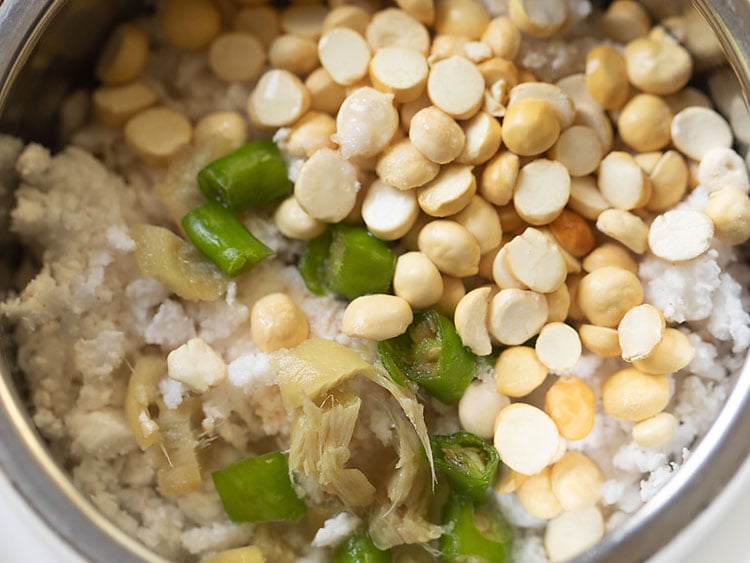
5. Grind to a smooth consistency. If the blade is unable to grind or the chutney looks thick, then you can add 1 to 2 tablespoons more water or as needed.
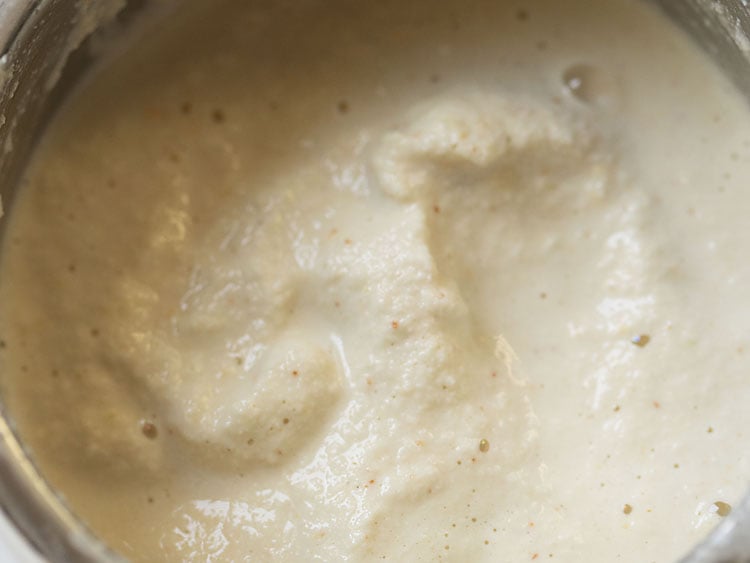
6. Remove the chutney with a spoon or spatula in a heat proof bowl (e.g. steel, pyrex or glass). Check the taste and add more salt if needed.
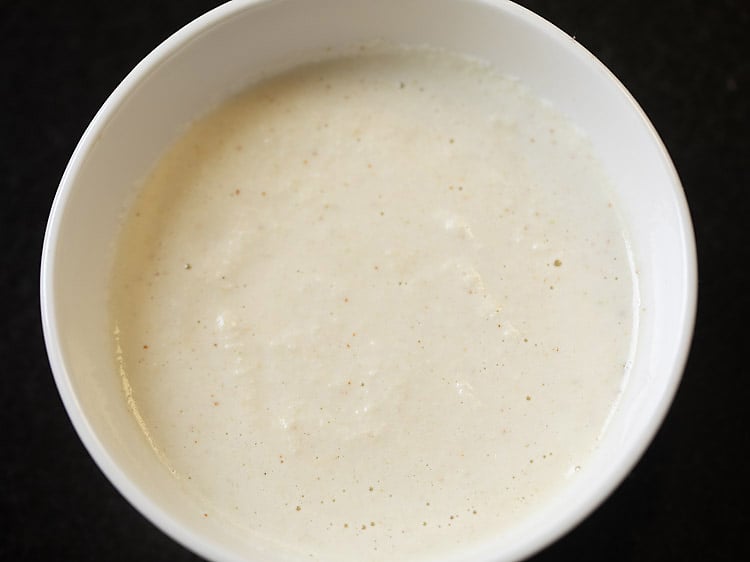
Tempering Coconut Chutney
7. In a small pan or a tadka pan, heat ½ tablespoon sesame oil (gingelly oil – made from raw sesame seeds) over low heat.
Note: You can also use sunflower oil, peanut oil, coconut oil or any neutral flavored oil.
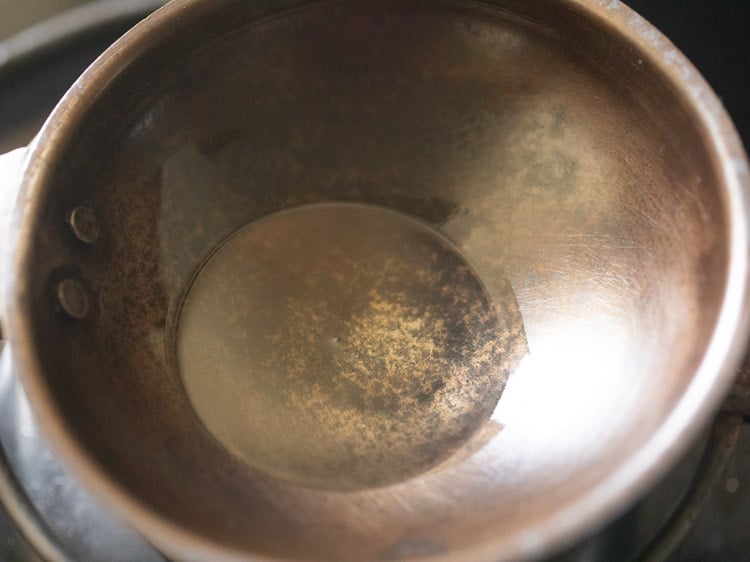
8. Add ½ teaspoon mustard seeds and let them begin to crackle.
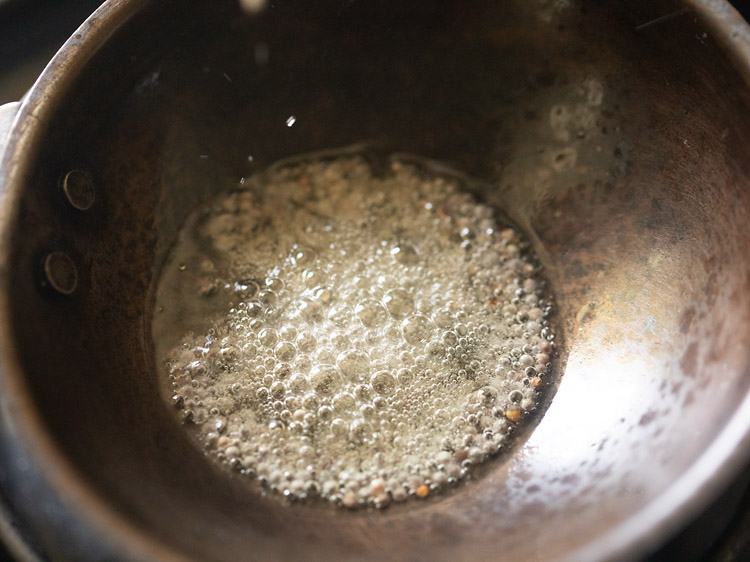
9. Once the mustard seeds begin to crackle, add ½ teaspoon urad dal (split and husked black gram).
Note: If you don’t have urad dal then feel free to skip in the recipe.
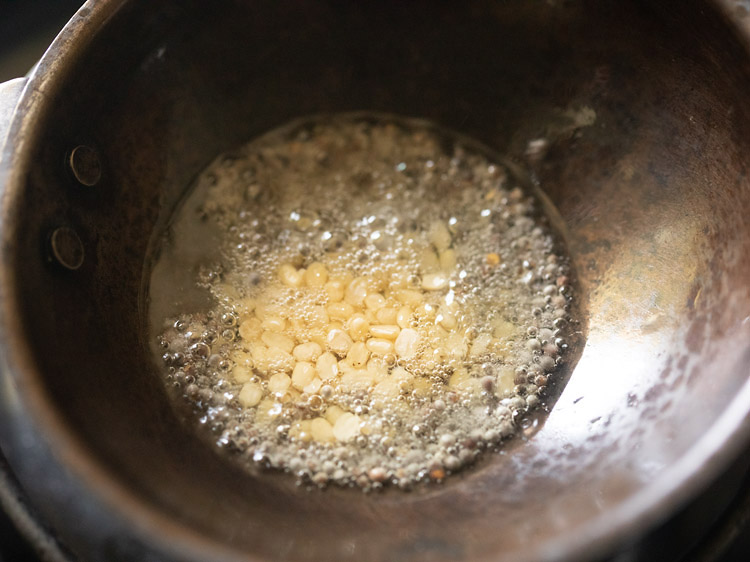
10. Next add ½ teaspoon cumin seeds. You can skip cumin seeds if you prefer.
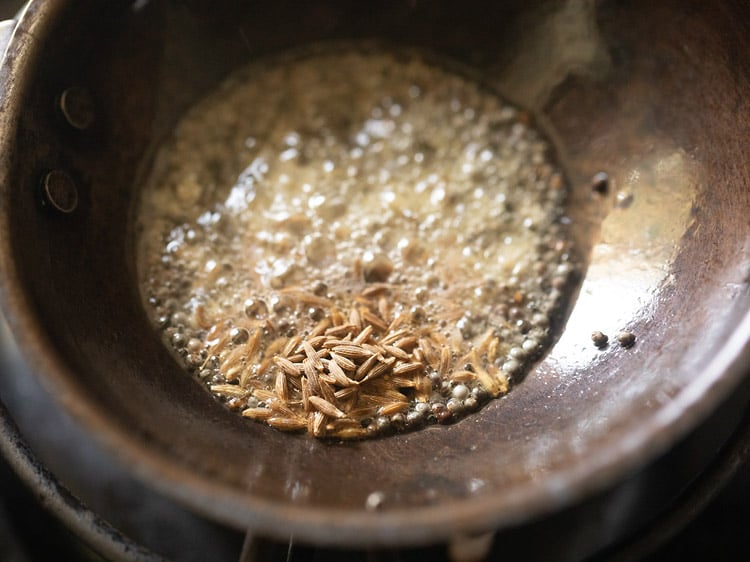
10. Stir often and fry keeping the flame to a low.
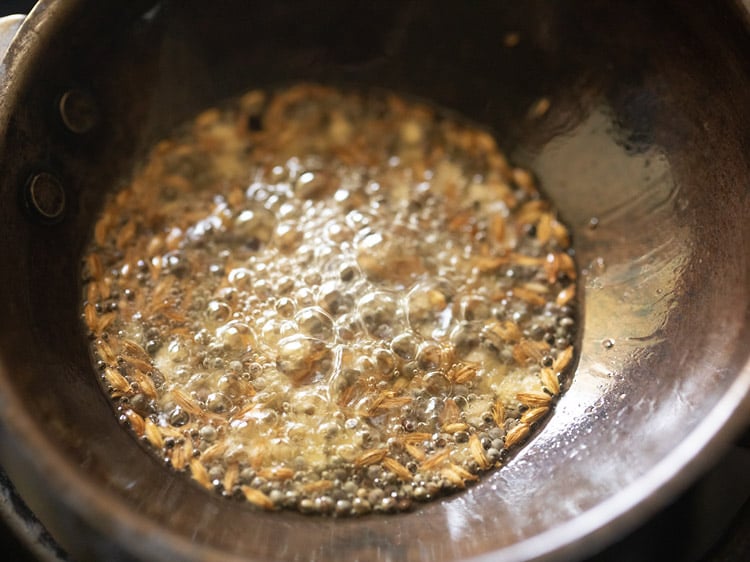
11. The urad dal should start becoming golden. The cumin seeds will also crackle and get browned.
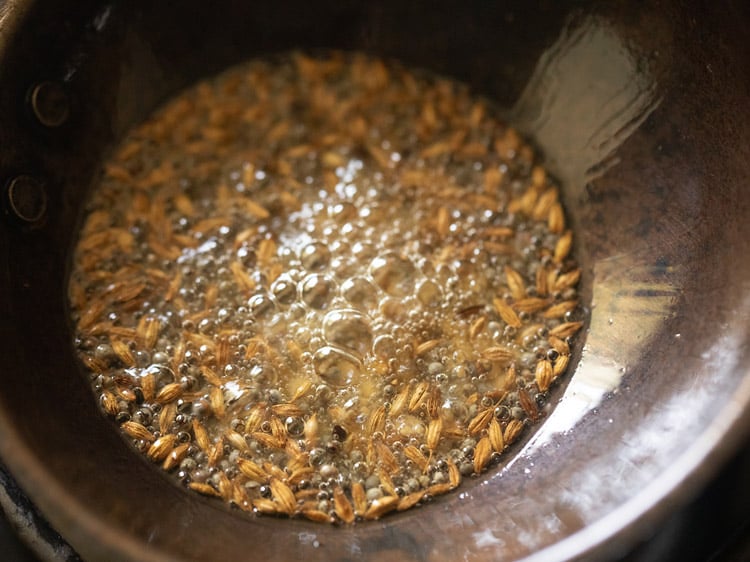
12. Once the urad dal begins to turn to a golden color, then add 1 dry red chilli (broken and seeds removed), 9 to 10 curry leaves and a pinch of asafoetida (hing). If the pan becomes very hot, then switch off the flame after adding the red chili, curry leaves and asafoetida.
Be careful as after adding the curry leaves the oil splutters.
Note: If you are gluten free, please be sure to check that your asafoetida is gluten free as many commercially available varieties are processed with wheat products.
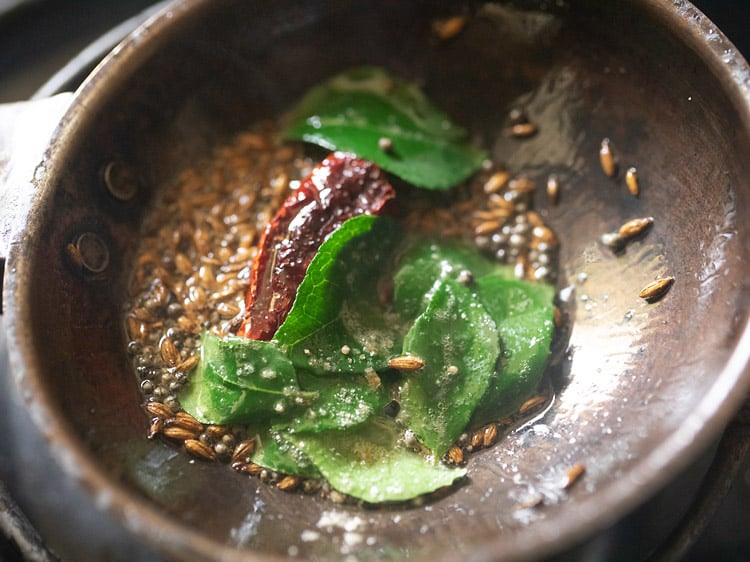
13. Stir and fry for a couple of seconds till the curry leaves become crisp and the red chilli changes color.
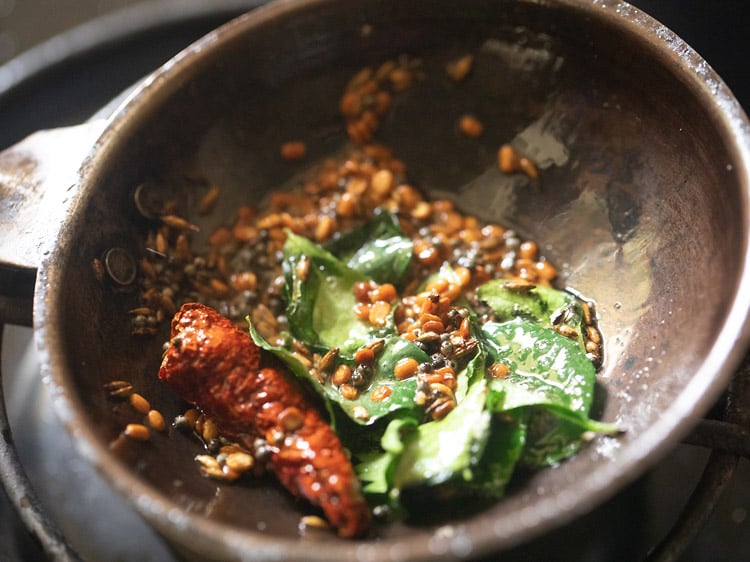
14. Switch off the flame and immediately pour the entire tempering together with the oil on the ground coconut chutney in the bowl.
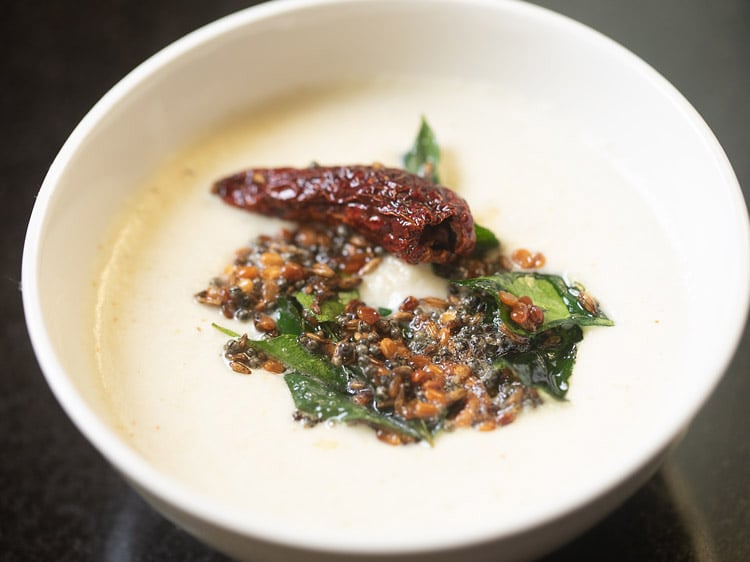
15. Mix very well.
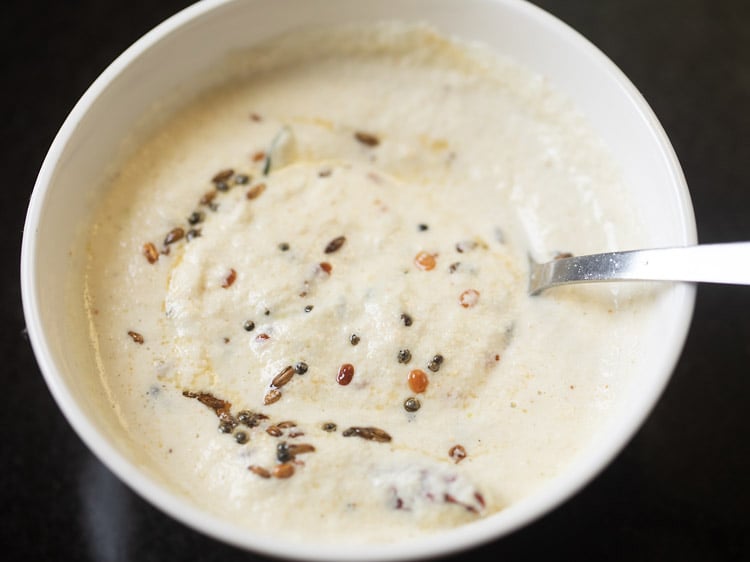
16. Serve coconut chutney with idli, dosa, vada, pongal or pakoda of your choice.
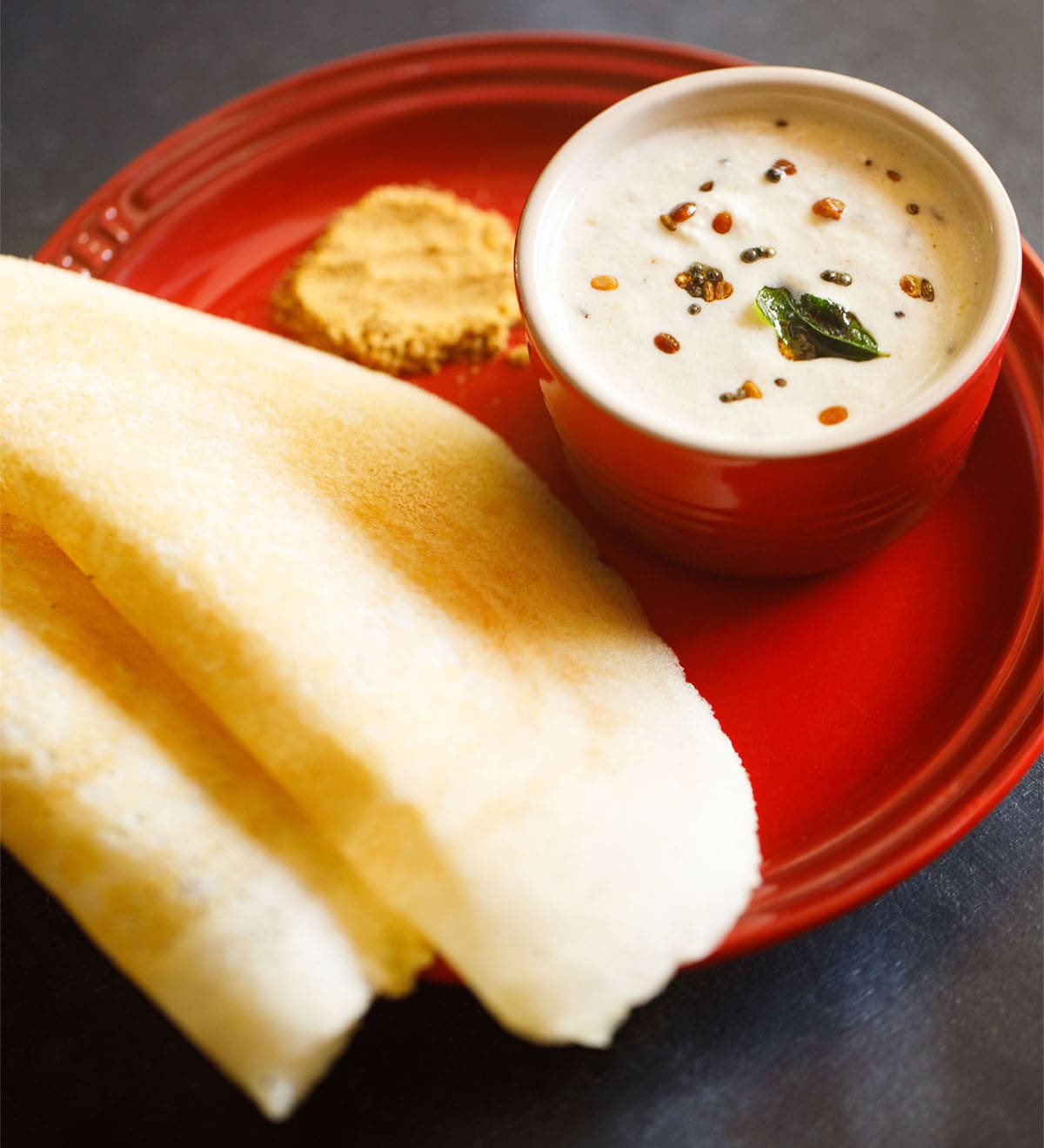
About Hotel Style Coconut Chutney
This is my quick coconut chutney recipe that also goes extremely well with idli, dosa, uttapam and medu vada. This vegan chutney also goes well with upma.
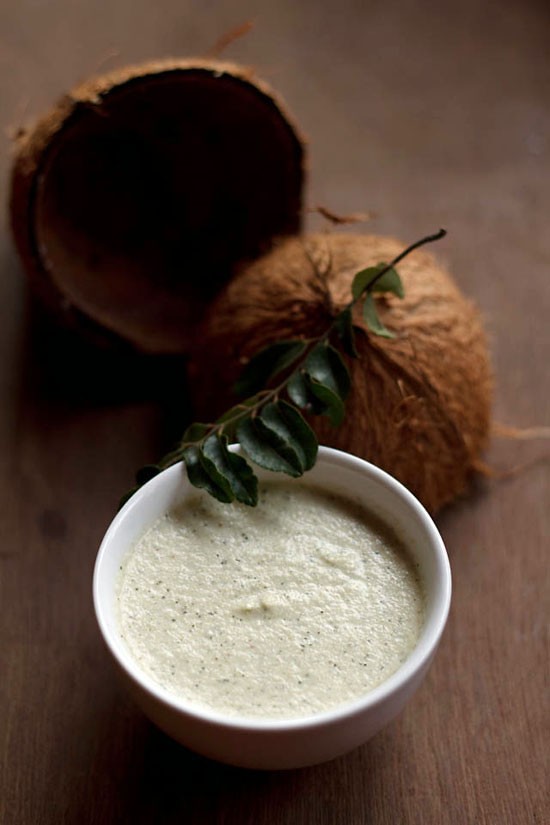
What contributes majorly to the earthy taste of this chutney is a good amount of roasted chana dal.
Here there is no tempering done but there is a bit of prep work which does not take much time. The curry leaves are fried and they get fried quickly releasing their fragrant flavors in the oil.
Thats what you need to do and then grind everything and the coconut chutney is ready to be served with dosa or idli or vada.
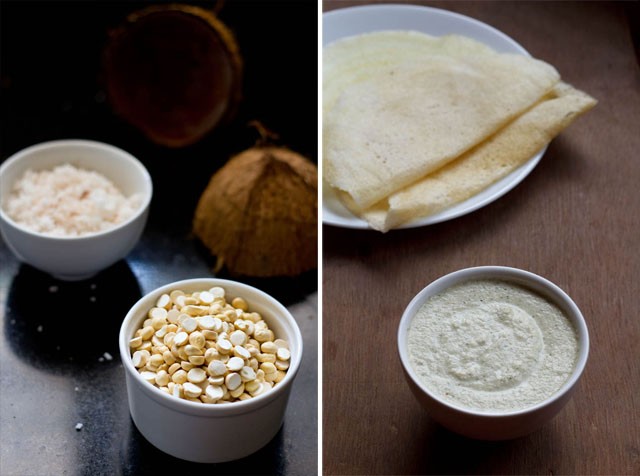
This coconut chutney recipe can be made with frozen or fresh coconut. To avoid grating coconut at the last minute, I usually grate the whole coconut and then freeze it.
When I want, I just take some of the frozen coconut and my work is easy whether it is making chutneys, sambar or vegetable stir-fries.
How to make Hotel Style Coconut Chutney
Ingredients
- ½ cup grated fresh or frozen coconut
- ¼ cup roasted chana dal (roasted bengal gram)
- ½ inch ginger – chopped
- 1 to 2 green chilies – chopped
- 15 to 20 curry leaves
- 2 teaspoons oil (coconut oil or sunflower oil)
- salt as required
- ¼ cup water or add as required
1. First heat 2 teaspoons oil (sunflower or coconut oil) in a frying pan. Keep the heat to a low. Then add 15 to 20 curry leaves.
Fry them stirring often till they become crisp and this takes just about 1 or 2 minutes. Remove the pan from the burner and set aside. Let this curry leaves and oil mixture cool.
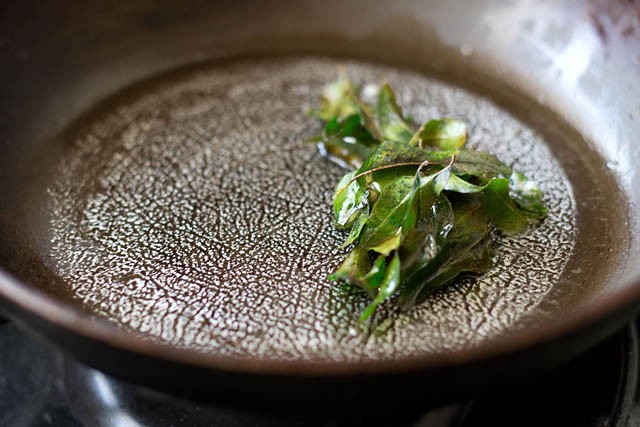
2. Put all the ingredients (½ cup grated fresh or frozen coconut, ¼ cup roasted chana dal, ½ inch chopped ginger, 1 to 2 green chillies and salt (as required) along with the curry leaves and the oil mixture in a chutney grinder or small blender.
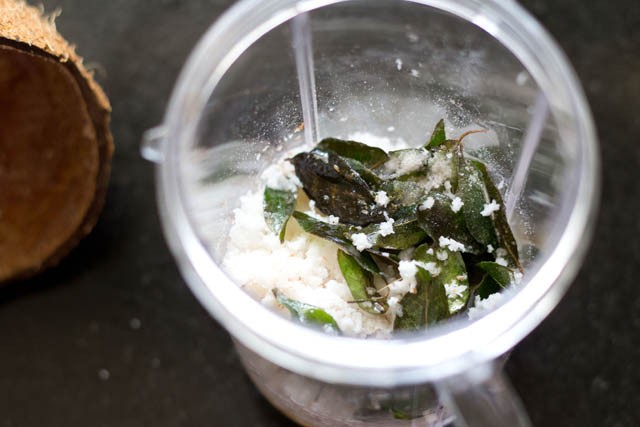
3. Add ¼ cup water or as required and grind to a smooth chutney. Do not add too much water. For a thicker consistency, add less water.
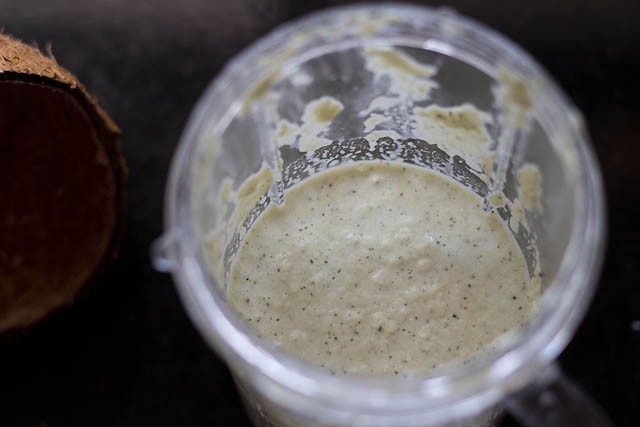
4: Serve the Hotel Style Coconut Chutney with plain dosa or rava dosa or rava idli or uttapam. Consume when fresh. At the most you can freeze the chutney and use it for a couple of days.
In cold temperatures, the chutney will stay longer for a few hours in the refrigerator than in warmer or hotter climate.
Coconut Chutney Variations
Myriad variations of coconut chutney can be made by adding extra ingredients like fresh mint leaves, coriander leaves, garlic, curd (yogurt), tamarind, tomatoes, onions, almonds, carrots, beetroot, unripe mangoes, peanuts, capsicum, and greens like spinach.
The ingredient(s) you add will change the flavor of the resulting coconut chutney – e.g. adding tamarind or tomatoes will impart a sour taste in the chutney, while adding fresh herbs like mint or coriander will add a bit of fresh, herb-y flavor to the final product.
I recommend that you experiment with different ideations of this delightful condiment because there are just so many to choose from! It is hard for me to pick my favorite.
Here are some of my most favorite coconut chutney recipes:
Chutney Recipes
Chutney Recipes
Chutney Recipes
Expert Tips for Coconut Chutney
- For a tangier chutney: If you like a little sourness in your coconut chutney, you can add one or both of the following ingredients:
- Tamarind: Take about ½ to 1 teaspoon of tamarind and grind it with the rest of the ingredients.
- Curd (yogurt): When the chutney mixture is ground, then take it in a bowl. Mix it with 2 to 3 tablespoons fresh curd or yogurt. This has to be done before you temper the coconut chutney.
- Serve immediately: Coconut chutney has to be consumed fresh. Avoid keeping the chutney at room temperature for very long. If you have to keep it for a few hours, then keep it in the freezer section of your refrigerator and consume the coconut chutney within a day.
- Increasing shelf life: Adding tamarind to the chutney increases its shelf life a little more. You can freeze the chutney for up to 1 day if tamarind is added.
- Using desiccated coconut: If you are using desiccated coconut or coconut powder, use warm water while grinding the chutney to get the right consistency.
- Scaling: You can easily halve, double or triple the recipe per your needs.
FAQs
Chutney is basically a condiment used to enhance the flavors of different dishes. You can either dip your food into it, or drizzle or dollop it over your preferred dishes. This coconut chutney recipe is particularly good when paired with South Indian breakfast foods and snacks.
Absolutely! If your coconut is already grated, there is no need to defrost it first. Also, please note that I recommend you use coconut that you have frozen for yourself, rather than opting for store bought packs.
Several readers have told me that the store-bought frozen coconut has separated for them when they go to grind it, resulting in a much different taste. To avoid this I recommend adding warm to slightly hot water while grinding the coconut.
You can also opt to use unsweetened desiccated coconut instead, which I have never had trouble with. Simply grind with warm water to get the right consistency in your coconut chutney recipe.
Yes! You can also opt to omit the roasted channa dal if you do not have access.
Serve Coconut Chutney With:
Breakfast Recipes
Breakfast Recipes
Breakfast Recipes
Breakfast Recipes
Please be sure to rate the recipe in the recipe card or leave a comment below if you have made it. For more vegetarian inspirations, Sign Up for my emails or follow me on Instagram, Youtube, Facebook, Pinterest or Twitter.
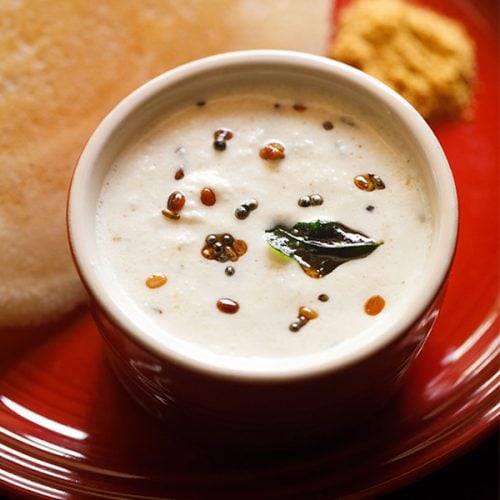
Coconut Chutney Recipe
Ingredients
for grinding
- ½ cup fresh grated coconut (tightly packed) or ½ cup desiccated coconut
- 2 tablespoons roasted chana dal – optional
- 1 or 2 green chilies or ½ teaspoon chopped green chillies or serrano or anaheim pepper
- ½ inch ginger – optional, you can also add 1 to 2 small garlic cloves
- salt as per taste
- 3 to 4 tablespoons water or add as required – for grinding
for tempering
- ½ teaspoon mustard seeds
- ½ teaspoon urad dal (split and husked black gram)
- ½ teaspoon cumin seeds – optional
- 9 to 10 curry leaves or 1 sprig of curry leaves
- 1 pinch asafoetida (hing)
- 1 dry red chili – broken and seeds removed
- ½ tablespoon oil – sesame or peanut or coconut or sunflower oil or any neutral oil
Instructions
Grinding Ingredients
- Take the freshly grated coconut in a chutney grinder jar or a small grinder jar.
- Then add the green chili and ginger.
- Next add the roasted chana dal. Also add salt as per taste. Add 3 to 4 tablespoons water.
- Grind to a smooth consistency. If unable to grind or the chutney looks thick, then you can add 1 to 2 tablespoons more water.
- Remove the chutney in a heatproof bowl like a steel bowl or a pyrex bowl.
Tempering
- Heat oil in a small pan. Add the mustard seeds.
- When the mustard seeds begin to splutter, add the cumin seeds and urad dal. Fry till the urad dal starts to become golden and aromatic.
- Then add the curry leaves, red chili and asafoetida.
- Fry for a couple of seconds till the curry leaves become crisp and the red chillies change color making sure that the curry leaves and chilies do not get burnt.
- Switch off the heat and immediately pour the tempering on the chutney in the bowl.
- Mix the tempering mixture very well.
- Serve coconut chutney with idli, dosa, vada, pongal or pakoda of your choice.
Video
Notes
- Scaling: This coconut chutney recipe can be halved or doubled or tripled.
- Spiciness: Add 2 to 3 green chillies for a spicy taste in the coconut chutney.
- Herbs: Instead of ginger, you can add garlic. Ginger can be skipped completely. You can even add some fresh coriander leaves (cilantro) or mint leaves.
- Dry Red Chillies: You can even add 2 to 3 dry Kashmiri red chillies or 1 to 2 dry red chillies and make a red coconut chutney. A bit of tamarind can be added if using dry red chillies to balance the pungency and heat of the chillies. Remove the seeds from the chillies before you grind them with the rest of the ingredients.
- To Make White Coconut Chutney:
- For a white coconut chutney, add less of the roasted chana dal or skip it entirely. So for this recipe add ½ tablespoon of roasted chana dal.
- Also add less green chillies or you can skip them.
- Do use only the white part of the coconut and not the brown part.
- You can even add some nut milk or thin coconut milk instead of water while grinding.
Nutrition Info (Approximate Values)
This coconut chutney recipe post from the archives (April 2014) has been republished and updated on 9 June 2021.
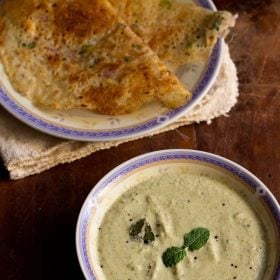
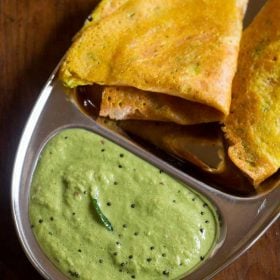
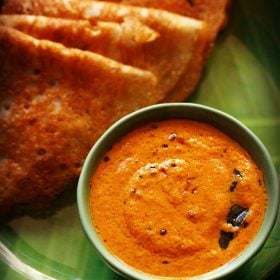
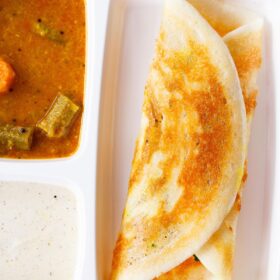
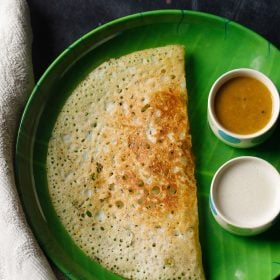
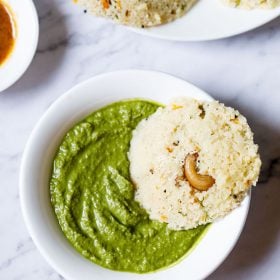
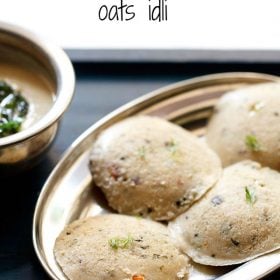
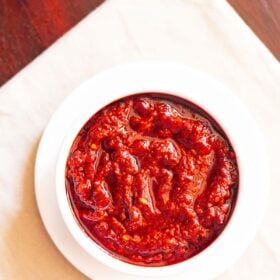
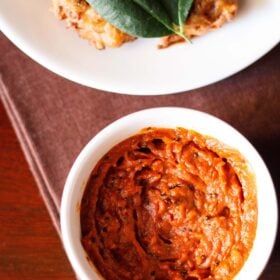
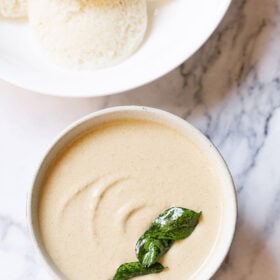
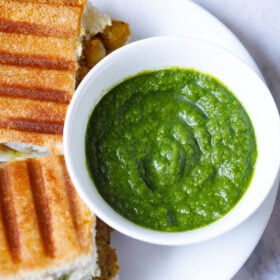








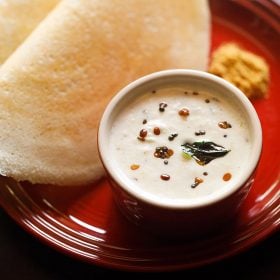
Love all your recipes!!
Thanks so much.
This chutney is too good! I can eat 3-4 portions at once.
Yes, us too. Thank you.
Are the chana dal boiled before roasting?
These roasted chana dal are commercially made and easily available online. They are cooked prior to roasting.
Good recipe. Made and liked it.
Good and like my family enjoy that
thanks and nice to know.
Hello,
Could you please let me know what happened with your ‘app’. I had often used it in the past to make so many delicious and wonderful recipes, unfortunately recently I noticed that your app is no longer available. I have been missing it a lot.
I just hope it is only temporary.
Thank you and have a pleasant evening!
Kamal
Welcome Kamal. We had to delete the app because of technical issues.
Good and like the taste of the coconut chutney also my family enjoying that with BANANA BAJJI RECIPE | VAZHAKKAI BAJJI RECIPE thanks and greatful to you
I made this recipe with the desiccated coconut. It was incredibly delicious and I will be making it again! The only differences I found were that I needed to add much more water to the desiccated coconut to make a good paste and I used a little more oil for the spice rendering.
My husband is from the Seychelles and we love indian food! Thank you for so many great recipes.
Welcome Kate. Glad to know this. Thanks for sharing your positive feedback on recipes.
I use frozen grated coconut, that I thaw in the fridge to make this chutney. but I’ve notice that if I grind enough to make a smooth paste, the cream separates from the coconut and the chutney becomes watery. How do I avoid this from happening. If I don’t grind enough the masalas don’t blend, but if I grind till it becomes a smooth paste, it separates. Please help
sanchali, i also use frozen coconut. but i don’t buy frozen coconut from market. i grate coconut with a table top grater. then store the grated coconut in a steel dabba in the freezer. when i want to use, i remove the required amount. i have never faced any issue with the cream separating. always the coconut blends well with the chutney. i do not thaw the coconut. i add it directly in the mixer or grinder jar and grind. so i am not sure why this is happening. may be you can try not thawing the coconut and then grinding it.
I also experienced the same problem several times. Whole character of the chutney alters when the cream separates after grinding. I use the store bought frozen grated coconut. I used to buy fresh coconuts way back but invariably 98% of the time, the whole coconuts are rotten inside. I got tired of this and started buying frozen coconut. I need to investigate why the cream is separating out of coconut.
rom, this happened with me only once when recently when i purchased a pack of frozen grated coconut. usually, i grate coconut and store in the freezer. but for the first time, i used a pack of frozen grated to make chutney and the cream separated. this has only happened with the readymade pack of frozen coconut. when i grate fresh coconut and keep in fridge, this does not happen. i know the chutney consistency, taste completely changes once the cream is separated. it no longer remains a coconut chutney ????. you can even try grinding with warm water. it helps.
Thankyou for demonstrating the recipe step by step. I have tried it is is ????????
Welcome Rawinder
Thanks I have gone through all .still I m always confused ,what means bhuna chana Dal.is it DALIYA WHICH WE GET AT FUTANAWAL,OR SHOUD I TAKE SPLIT CHANA DAL AND FRY IN OIL OR JUST BHUNANA OR USE SOKED CHANA DAL WHICH
TASTES GOOD .I LEAVE ALONE AS FAMILY IS OUT OF STATION.RAJIV
it is the daliya or futana which is roasted chana dal. you can also fry chana dal in oil and then use it. if you use soaked chana dal, then just fry it in some oil and then add while grinding. for daliya or futana, remove the outer brown cover of the chana before adding.
A big , big hit in my family.
Thanks a bunch for the recipe.
🙂
Welcome Bharti
This recipe is a big hit with my husband who is a big fan of South Indian cuisine.
How much ever I thank you, it’s not enough!!
A big bunch of thanks to you.
Xoxo
Welcome Bharti. Thanks for this sweet and positive feedback.